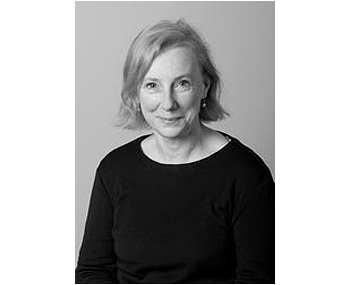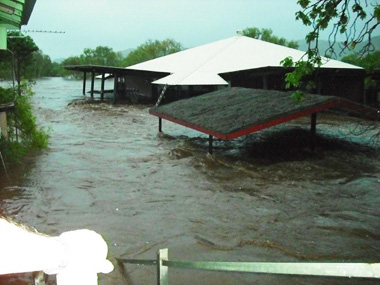NEW HIGH-TECH CONSERVATION & ATTRIBUTION CENTRE IN MELBOURNE

The Centre for Cultural Materials Conservation (Photo courtesy University of Melbourne)
Aboriginal Art Directory | 15.04.15
Author: Jeremy Eccles
News source: Interview
Jeremy Eccles interviews Prof Robyn Sloggett, Director of the Centre for Cultural Materials Conservation (CCMC) at the University of Melbourne about art fakery, new technology - and her special relationship with Warrmun. The interview forms part of an article on Provenance by Jennifer Isaacs AM, contributing writer for the AAD.
The legendary Professor Robyn Sloggett has a new $7m laboratory to play with thanks to Grimwade and Cripps Foundation funding at the University of Melbourne. Many an artwork will now be tested to its billionth part by electron microscopes, the chemistry of paint, ochre, bark and canvas can 'enjoy' accelerated ageing to find out how they'll survive the ages, even in desert or tropical conditions, and art fakery will get just a little harder under the eagle eyes of both experts and technology like Raman spectroscopy. No wonder the Grimwade Centre for Conservation Materials is already attracting almost a hundred PhD students from Australia, Asia and the US.
And there's a philosophical side to the former art historian Sloggett too. She sees her job as “a way of thinking, a way to assist in the preservation of Australian culture with links to the intangible. And that's not just Indigenous culture – I see a new orality, which Aborigines would understand, in the growth of the digital realm – how do we conserve Instagrams???”.
But, back to the CSI side of Sloggett's role, she was a key prosecution witness in the Liberto case – a rare criminal prosecution - involving fake Rover Thomas paintings. In court, she provided detailed testimony about the various materials used in the production of the suspect paintings. Sand, she said had been mixed into the paint that had been applied to the canvas, in an effort to simulate the way desert dust gets on to paintings in remote art centres. "We were able to compare with genuine works by Rover Thomas where sand was present, but only because it had been blown on to the surface of the wet paint”. Also Conte crayon had been rubbed on to the back of the works to give the effect of red dust, while dirt had been rubbed into white dots on the painting for an 'aged' look.
And only three of five auctioneers offered the works were taken in!
Now, in the new laboratory, Sloggett says “we can take one research question and follow it through completely in a single place - teams with different specialities working together. Also we've got fabulous audio-visual equipment that means we can put up the old people in Warrmun on to a big screen in Melbourne and talk things through”.
The Warrmun link grew from the terrible flood that damaged so much work at the Turkey Creek art centre in The Kimberley – and much ended up being nurtured and conserved in Melbourne. And that relationship continues with a fund-raising dinner on 16th April in the new labs. Apart from seeing this work in progress, the doughty Marcia Langton will deliver a provocative address: 'The significance of small, remote Indigenous communities and Aboriginal art centres to Australia’s economy and the nation’s wellbeing'. Might give the PM or WA Premier cause for indigestion!
Last year, Sloggett with both staff and students from her old Centre for Cultural Materials Conservation got out there to remote communities during ANKAAA's wonderful 'Harvesting Traditional Knowledge' project, putting institutional conservators with the people who make the art in The Kimberley and Arnhemland. “Such meaningful relationships developed”, recalled Sloggett. “And we discovered just how sophisticated the artists were in their understanding of their materials. We just hadn't considered the continuity of practice involved in harvesting bark from trees – what they're doing today is pretty much the same as when Baldwin Spencer collected barks from there in 1912”.
Shouldn't we also be considering that little thing called aesthetics? “You're right - our science is really only the last 2% of the answer”, admitted the woman with so much science now at her command. “You've got to start by really looking at something, trying to put yourself in the artist's shoes. What is their choice of paint, brushes and canvas? They're consistent matters with most artists. But when you need the science, it's really useful for lining up all the ducks. The age of a paint becomes absolutely clear when you can blow a patch up hundreds of times and discover, say, an artificial ultramarine, not synthesised until 1830, on a supposed Canaletto. He died in 1768 having used only natural ultramarine. Or observe each one of the 25 layers of brushstrokes characteristic of a Fairweather painting – that's almost impossible to fake”.
Finally, Robyn Sloggett emphasises that it's actually less of either an inside understanding or the CSI stuff and more “an independent verification of a work's first provenance” that is the key to linking an artwork to the original artist. “And that's often harder in Aboriginal than in non-Indigenous art – the industry is so much looser; and the scholarship's just not there. How do you check the facts about the origins of a Rover Thomas painting when there's been no continuity in the maintenance of any archive or records in Warrmun? But an interesting difference (between the two markets) is that the structure of the white market supports the survival of a fake if it's managed to avoid the checks and balances at entry”.
Fundraising Dinner
A relationship between the CCMC Laboratory and Warrmun has grown out of a flood that damaged the Art Centre, and the artworks which ended up being conserved in Melbourne. This year that relationship continues with a fund-raising dinner being held tomorrow evening, 16 April 2015.
Marcia Langton will deliver the provocative address: The significance of small, remote Indigenous communities and Aboriginal art centres to Australia's economy and the Nation's well-being.
We're told a few tickets may be left, so be quick. The cost is $150 to gift-processing (at) unimelb (dot) edu (dot) au
Enquiries: mmscott (at) unimelb (dot) edu (dot) au or tould (at) unimelb (dot) edu (dot) au
About
Prof Robyn Sloggett is Director of the Centre for Cultural Materials Conservation (CCMC). She has qualifications in Art History, Philosophy and Cultural Materials Conservation. As Director she manages the diverse conservation, teaching and research programs. CCMC also delivers the only comprehensive post-graduate conservation professional programme in the Australasia-Pacific region, as well as courses in Art Authentication and Photographic Preservation.
In 2004 Robyn was awarded the Australian Institute for Cultural Materials Conservation's Conservator of the Year Award for service to the profession.
URL: http://www.commercial.unimelb.edu.au/ccmc-conservation-services
Share this:
»  del.icio.us
»
del.icio.us
»  Digg it
»
Digg it
»  reddit
»
reddit
»  Google
»
Google
»  StumbleUpon
»
StumbleUpon
»  Technorati
»
Technorati
»  Facebook
Facebook
Contact Details

Prof Robyn Sloggett, Director Centre for Cultural Materials Conservation (Photo courtesy University of Melbourne)

The Warrmun Art Centre, destroyed by floods. Each year the CCMC hold a fundraising dinner for Warrmun, this year's Guest Speaker is Marcia Langton - see details above
Further Research
News Tags: ANKAAA | Arnhemland | art fakes | art fraud | Conservation | Grimwade and Cripps Foundation | Jeremy Eccles | Kimberley | Marcia Langton | Prof Robyn Sloggett | Turkey Creek | University of Melbourne | Warrmun
News Archive
- 11.10.17 | RETURN OF MUNGO MAN
- 10.10.17 | TARNANTHI 2017
- 11.08.17 | Natsiaas 2017
- 08.08.17 | ABORIGINAL ART ECONOMICS
- 02.08.17 | SCHOLL'S NEXT MOVE
- 20.07.17 | APY ART DOMINATES THE WYNNE
- 17.07.17 | Anangu Artist Wins $100,000 Prize
- 14.07.17 | The End of AAMU
- 13.07.17 | YOU ARE HERE
- 11.07.17 | ART ACROSS THE COUNTRY
- 11.07.17 | TARNANTHI IN OCTOBER
- 05.07.17 | TJUNGUṈUTJA - from having come together
- 02.07.17 | BENNELONG
- 27.06.17 | JIMMY CHI
- 23.06.17 | Blak Markets at Barangaroo
Advertising

